February 13, 2010
F1 Pr0n: Lotus T127
British Racing Green is back in Formula 1 with the reveal of the new 2010 Lotus T127 on Friday!
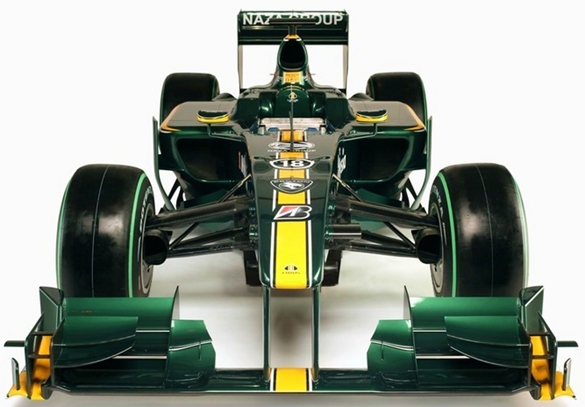
Reportedly there are a lot of ex-Toyota people working for the Malaysian-based team, which could explain why the nose reminds me of Toyota's TF109. Not the wing, but the vertical mounting and the nose cone itself. One thing we haven't seen yet with this season's debuts are these sidepods. The tops are dead flat on the Lotus, as opposed to swooping or curved; interesting look, this.
more...
Posted by: Wonderduck at
10:21 AM
| Comments (6)
| Add Comment
Post contains 204 words, total size 2 kb.
1
That first picture seems like looking at a grin with a couple of teeth missing. It seems rather empty and open compared to a lot of the other cars you've posted about.
Is it because the front wing is smaller?
Posted by: Steven Den Beste at February 13, 2010 01:20 PM (+rSRq)
2
Maybe it's the camera angle.
Posted by: Steven Den Beste at February 13, 2010 01:21 PM (+rSRq)
3
It's the angle. Most of the glamour shots from the front are taken from right about the height of the driver's eyes when he's in the cockpit, but there just weren't any for the Lotus from that p.o.v. Believe me, I spent about an hour scouring my sources looking for one, but no soap.
There's something weird about this car and optical illusions anyway. Right up until I was about to hit "post", I thought that the dorsal fin was not the usual razor-thickness, but that it was actually wide enough to contain an exhaust port. Look at the fourth picture and maybe you'll see why I thought that!
I had a lot of speculation as to what benefit that'd bring, and I came to the conclusion that it'd help downforce (much like a blown flap on an airplane creates lift) since it looks like it'd be exhausting right over the rear wing, but they'd then have to deal with the heat burning or melting the wing elements. Then I realized what I REALLY was looking at, felt silly, and deleted the whole paragraph.
Posted by: Wonderduck at February 13, 2010 03:52 PM (G8/ak)
4
I really like the color scheme, even though paint isn't known to help win races.
Posted by: Steven Den Beste at February 13, 2010 03:53 PM (+rSRq)
5
Way too many straight lines for a modern car.
Posted by: Pete Zaitcev at February 14, 2010 12:42 AM (/ppBw)
6
OT: There's a picture of Winry with a couple of ducks in
this post.
Posted by: Steven Den Beste at February 14, 2010 07:19 PM (+rSRq)
Hide Comments
| Add Comment
February 10, 2010
F1 Pr0n: Red Bull RB6
And so last year's runner-up has finally brought their challenger to the track, and how does it stack up?
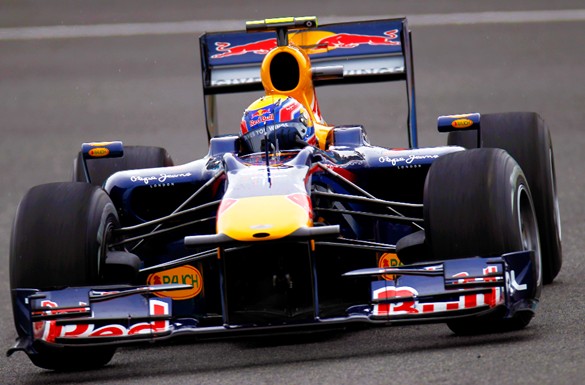
Um... it's pretty much the same.
more...
Posted by: Wonderduck at
08:16 PM
| No Comments
| Add Comment
Post contains 192 words, total size 1 kb.
February 09, 2010
F1 Pr0n: Force India VJM-03
Force India was my choice for "most improved" team last year, so I've
been eagerly awaiting their 2010 charger. Would they make radical
changes? Gently evolve? Leave the car be?
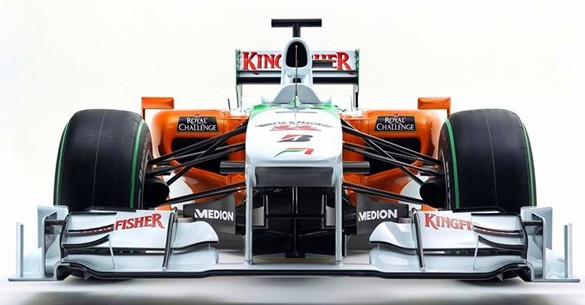
The answer turns out to be "evolve." Nothing shocking here; the only real changes are those prescribed by the rule book.
more...
Posted by: Wonderduck at
08:10 PM
| Comments (6)
| Add Comment
Post contains 213 words, total size 2 kb.
1
I think they've got the highest nose of any of the cars you've shown us so far.
Posted by: Steven Den Beste at February 09, 2010 08:37 PM (+rSRq)
2
Either them or the Williams, yep.
Next rollout that I'm aware of is Red Bull's RB6, which is expected to be on track tomorrow at the second test session, in Jerez.
Posted by: Wonderduck at February 09, 2010 09:32 PM (G8/ak)
3
I think it's just cameras.
Posted by: Pete Zaitcev at February 10, 2010 12:25 AM (/ppBw)
4
No, below the camera mount, Pete.
Posted by: Wonderduck at February 10, 2010 07:12 AM (G8/ak)
5
Not my favorite car so far, but certainly colorful.
Posted by: Mallory at February 10, 2010 09:11 AM (WJ2qy)
6
I think it maybe used to generate a venturi in front of the plank it may generate additional ground effect.
Posted by: le-reve at February 12, 2010 08:41 AM (Y8guG)
Hide Comments
| Add Comment
February 03, 2010
F1 Pr0n: Virgin Racing VR-1
The virgin Virgin Racing team debuted their first car online today, and it's different...
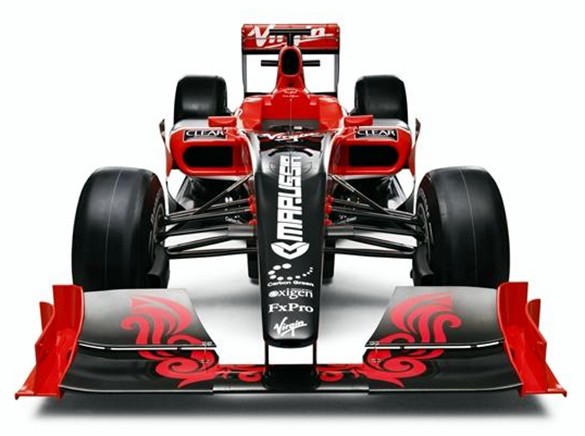
Touted as the first F1 car designed entirely in computer with zero wind tunnel testing, the VR-01 appears to have some roots in the
IRL. Which makes perfect sense, considering that Virgin's technical designer, Nick Wirth, did a lot of work with Dallara on their IRL chassis. Specifically, that nose! Mosquitos have wider probosces. Compare the VR-01's needle-point nose to the humongous beak on the Renault, for example.
more...
Posted by: Wonderduck at
03:50 PM
| Comments (1)
| Add Comment
Post contains 298 words, total size 2 kb.
1
I must say I like it, especially the curly-cue design. I hope it gets some testing somewhere along the way, though.
Posted by: Mallory at February 03, 2010 04:24 PM (WJ2qy)
Hide Comments
| Add Comment
February 01, 2010
F1 Pr0n: Toro Rosso STR5
In many ways the Toro Rosso STR5 has been the car I've been most looking forward to. This is the first time the team has had to field an original design, as opposed to being a "client chassis" of the parent Red Bull team. This puts them in an interesting position of being an experienced F1 team, but never having built their own car. The question in my mind was how inventive they would be.
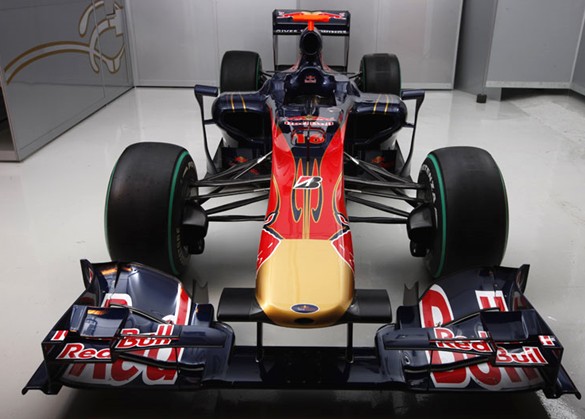
The answer turned out to be "not very." It's essentially an updated STR4, which was the safe way to go for a relatively small team with an all-new design staff.
more...
Posted by: Wonderduck at
10:18 PM
| Comments (3)
| Add Comment
Post contains 222 words, total size 1 kb.
1
Yep, gotta love the flames. :-)
Posted by: Mallory at February 01, 2010 10:57 PM (WJ2qy)
2
I am not sure, but I think I can see the pullrod read suspension from here (3rd picture).
Posted by: Pete Zaitcev at February 02, 2010 12:41 AM (/ppBw)
3
Hmmm... I agree the rear suspensenion does look like the same system used on the RB5 slightly different rear packaging though.
Posted by: le-reve at February 02, 2010 06:50 PM (Y8guG)
Hide Comments
| Add Comment
F1 Pr0n: Williams FW32
Williams rolled out their new car at the first test in Valencia, and it's... conventional.
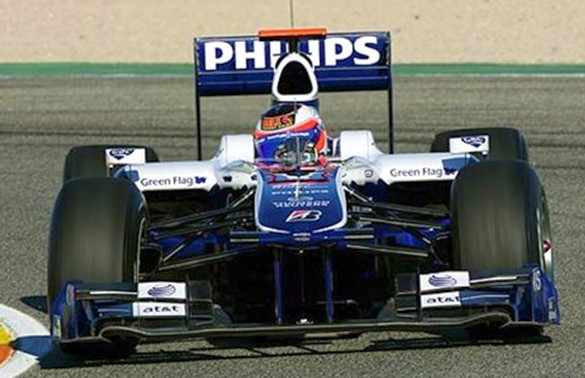
High nose with just a small downward angle. Larger sidepod intakes. Pretty vanilla.
more...
Posted by: Wonderduck at
09:58 PM
| No Comments
| Add Comment
Post contains 140 words, total size 1 kb.
F1 Pr0n: Mercedes MGP-W01
Mercedes brought out their 2010 steed today, and it's pretty clear why they didn't want to roll their car out first. It's got some interesting things in it, things that we haven't seen before!
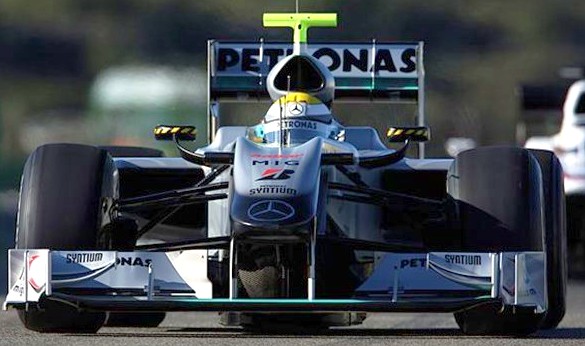
No glamour pics, I'm afraid. Reportedly, this chassis has been worked on (as the Brawn BGP-02) since the 2009 "summer break", so they've already filed off the rough edges. It's a high nose (though not as high as some), with a serious nod to last year's Red Bull RB5 in that it copies the "V-nose" concept. You'll note the raised edges, which in the MGP-W01 run all the way back to the cockpit. The sidepod openings are huge in comparison to those in the McLaren or Ferrari. The really innovative bit, however, is the air intake above the driver's head. The structure serves two purposes on a F1 car: it gets air to the engine (ergo the name) and it acts as a roll bar to protect the driver in case the car ends up upside down. In the past, the entire thing has been protective, built up out of carbon fiber to meet the required strength. In the Mercedes, however, there is a thick vertical support on the centerline of the airbox that serves the same purpose. The inlet is, in effect, split into two and is considerably larger as a result.
more...
Posted by: Wonderduck at
09:44 PM
| Comments (1)
| Add Comment
Post contains 353 words, total size 2 kb.
1
No cookie cutter cars this season. Great look on the Mercedes.
Posted by: Mallory at February 01, 2010 10:54 PM (WJ2qy)
Hide Comments
| Add Comment
27kb generated in CPU 0.015, elapsed 0.3697 seconds.
49 queries taking 0.36 seconds, 136 records returned.
Powered by Minx 1.1.6c-pink.
















